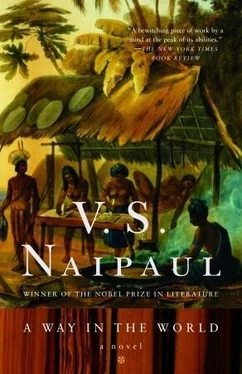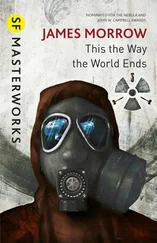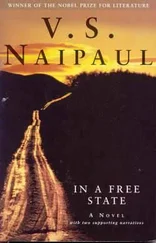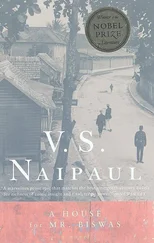“His own death came quite soon, when we got to the capital. The prison was on the river. He wanted me to put on my best clothes to witness what they did to him. And I did. I could hardly bear to go back to the room afterwards. I turned my face to the wall and looked at the sky in it.
“There was an English nobleman who wanted me to join his household. The old man had known of this and had liked the idea. But my grief was too great. After getting to feel for the Berrios, and then that afternoon for Don Palmita, and afterwards for the English commander, and then for the old man, moving on in a chain of death from one man to his enemy; after the journey in the great ocean; I felt I would die if I couldn’t get back to the beginning, to the first world I knew.
“The English behaved well. They could have kept me and made me wear feathers. But they told the Spanish ambassador. He was a relation of Don Palmita. The ambassador made arrangements to send me to Spain. Before I left they gave me English clothes, including some of the old man’s that I had already worn. In Spain I went to the great city of Seville, where the galleons filled the river, and from there I travelled in one of the galleons to Cartagena. And now I am here.”
FRAY SIMÓN said, “You’ve crossed the ocean twice. You are back here in New Granada, in the very town where you were born. You didn’t get lost. The ships always knew where they were going. When you consider the great fear you used to have of the oceans, what do you think now?”
“I’ve thought a lot about that. And I think, Father, that the difference between us, who are Indians, or half Indians, and people like the Spaniards and the English and the Dutch and the French, people who know how to go where they are going, I think that for them the world is a safer place.”
WHEN I BEGAN to write of it, the Trinidad landscape that was present to me was the landscape I had known as a child and felt myself part of — the western parts of Port of Spain; the forested hills to the north-west; the sugar-cane plains to the south, with the neat fields coming right up to the huts and houses and bare yards of villages lining the narrow and very black asphalt roads; the coconut estates on the muddy Atlantic coast, where the tall grey coconut trunks made a constant criss-crossing pattern as you drove by: a simple small-island geography.
Later, in London, when I was writing a book of history, I studied for many months the historical documents of the region. The documents (the early ones were copies of Spanish originals stored in Seville) took me back to the discovery. They gave me a sense of a crowded aboriginal Indian island, busy about its own affairs, and almost without relation to what I had known. A sense, rather than a vision: little was convincingly described in those early documents, and few concrete details were given. In my mind’s eye I created an imaginary landscape for the aboriginal peoples living — on what was to become my own ground — with ideas I couldn’t enter, ideas of time, distance, the past, the natural world, human existence. A different weather seemed to attach to this vanished landscape (like the unnatural weather in an illuminated painted panorama in a museum glasscase), a different sky.
The landscape I had grown up in, and felt myself part of, had been wiped clean of this other past. I had always known that, but I hadn’t been able to feel it as something that had really happened. In the first book of Nelson’s West Indian History, by Captain Daniel of the Trinidad Education Department, a textbook we used at the elementary school in Port of Spain, there was a short early chapter about the Caribs and the Arawaks. Perhaps very little was known about those people; perhaps Captain Daniel didn’t have much to play with. I remember nothing of what he wrote — except that the Caribs were fierce and the Arawaks gentle — and have no memory even of the illustrations he used. Because they had ceased to exist, and were not real, the aboriginals of our own island offered less to the imagination than the still living people we read about in Homes Far Away in the geography class: Kirghiz in shady black tents on their boundless, empty steppes, Eskimos crawling in and out of their warm ice igloos, Africans in their stockades at night, safe against marauding lions and other wild animals.
The idea of a recent wiped-out past was too big for a child in an elementary school to grasp. Later it became difficult in another way. As soon as you tried to enter that idea, it ramified. And it ramified more and more as your understanding grew: different people living for centuries where we now trod, with our own overwhelming concerns: different people, with their own calendar and reverences and ideas of human association, different houses or huts, different roads or paths, different crops and fields and vegetation (and seasons), different views, speeds, reasons for journeys, different ideas of the ages of man, different ideas of the enemy and fellowship and sanctity and what men owed themselves.
In this way, leaving aside the primary notion of cruelty, the idea of a wiped-out, complete past below one’s feet quickly became almost metaphysical. The world appeared to lose some of its substance; reality became fluid. It was more natural to let go, to let the mind spring back to an everyday, ground-level vision that took in only what could be seen.
It was easier in London, separated by many years and some thousands of miles from that ground-level view, and while I read in the British Museum and the Public Record Office, to feel the truth of the other, aboriginal island. From that distance, from that other side, as it were, the landscape of the aboriginal island became fabulous. And it was that landscape — which I wrote about without actually seeing — that I half looked for whenever afterwards I went back to Trinidad.
I found it mainly on the coast, and sometimes in glimpses of the Gulf and the North Coast from certain hills above Port of Spain. I found it inland once, after a highway had been driven through the lower hills of the Central Range. The land here, too broken for fields and roads, would always have been covered by forest or woodland or bush. Now it was stripped, shaved down to a kind of rough grass, and all its ridges and hollows were revealed. It looked unused. It was like another landscape; it was like a bit of the past just revealed and still fresh.
Over land like this, perhaps over this very spot, an Elizabethan nobleman, with thirty soldiers from his ship, all in armour, had gone one night on a long march looking for Indian gold. The hills and ravines and the vegetable debris of the tropical forest — near here, on land now shaved to grass — made marching very hard. To terrorize the Indians, the intruders blew trumpets and fired off their muskets. The Indians ran from their houses; in one village they even left food cooking (“seething”) on fires. The soldiers ate the food. They found no gold, though the nobleman thought he saw gold-dross at the bottom of an Indian pot. Later — to complete this New World romance — the soldiers thought they heard Indian war-pipes in the forest. No misadventure befell them, however; and in the morning they marched back to the coast and their ship.
What the food in the Indian village was, whether maize or cassava or potato or meat or fish, how it was seasoned, the pots it seethed in, what the fireplaces were like, and the houses — none of this is known. Captain Wyatt, who wrote an account of the expedition, had no eye for that kind of detail. He had strong literary tastes, and had his own idea of what should be written about. He knew parts of The Spanish Tragedy , a new London play, by heart; in the New World, on the Gulf shore of Trinidad, or in the forests, he saw his general and himself and the soldiers (and the Spanish enemy, and the Indians in the forest) as figures in a romance of chivalry.
Читать дальше












